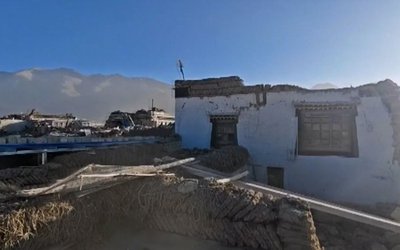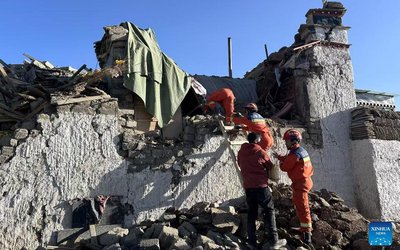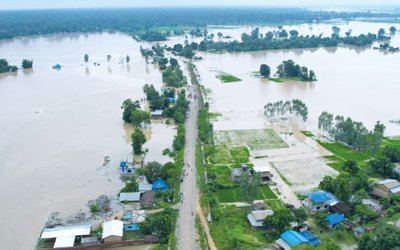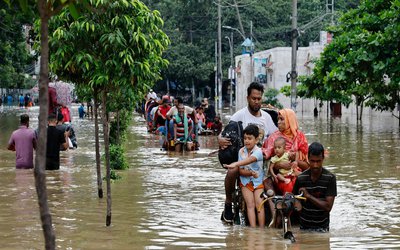
After experiencing several recent earthquakes, including one in Kathmandu, the 6.3 magnitude earthquake that occurred on Friday night, November 3, and was felt in many parts of Nepal and Western India, including New Delhi, serves as an early warning for preparation.
According to seismologists, a bigger earthquake, possibly exceeding 8 Richter scale, seems to be on its way. Given that Nepal and India are located in a seismic zone prone to earthquakes, it is expected that they will experience frequent seismic activity. Nepal must remain alert at all times, recognizing that earthquakes can strike at any moment.
The recent midnight earthquake resulted in over 160 fatalities and over 200 injuries. However, the Nepal Army, security forces, and local institutions responded promptly.

The earthquake in Jajarkot, Nepal resulted in over 150 deaths and 175 injuries, according to Indian officials. The quake caused buildings to collapse in the area and even shook buildings as far as New Delhi in neighboring India.
Nepal's National Seismological Centre reported that the earthquake occurred on Friday (November 3) at 11:47 p.m. (1802 GMT) with a magnitude of 6.4. The earthquake was measured at 5.7 by the German Research Centre for Geosciences, who downgraded it from the initial reading of 6.2. The U.S. Geological Survey recorded the quake at 5.6.
India demonstrated solidarity providing a prompt response of support along with Nepal's security agencies, political leadership, civil service, and local civil society. India's Prime Minister, Narendra Modi, expressed profound sadness over the loss of life and property resulting from the earthquake in western Nepal stating ."India stands in solidarity with the people of Nepal".
"India is prepared to provide any assistance deemed necessary," stated Indian Prime Minister Modi on Twitter. He expressed his condolences to the families of the victims and hopes for a speedy recovery for the injured.
With extensive experience in rescue and relief efforts, the Nepal Army promptly mobilized their forces in the affected region and successfully rescued numerous individuals.
Earthquakes that strike the western region of Nepal have an impact on the Gangetic plains because the soft soil in the areas amplifiers the seismic energy. Seismologists attribute this phenomenon to the collision between the Indian plate and the Eurasian plate. The recent earthquake in Jajarkot, which was caused by this collision, also affected western India, including New Delhi.
India's National Centre for Seismology (NCS) stated that the earthquake's epicenter was in Nepal, approximately 227 km north of Ajodhya in Uttar Pradesh and 331 km west-northwest of Kathmandu. The earthquake hit around 11:30 pm.
Indian seismologists assert that earthquakes in the Himalayan region will have a significant impact on population centers such as Delhi and the Gangetic Plains. This is due to the amplification of seismic energy caused by soft soil. CP Rajendran, Adjunct Professor at the National Institute of Advanced Studies in Bangalore, supports this view.
The areas susceptible to future significant seismic activity are the Indus-Gangetic-Brahmaputra Plains, extending from Jammu in the Northwest to upper Assam in the Northeast, according to the source.
In Bihar, the earthquake that struck Kathmandu on October 22nd was reportedly felt, as indicated by the NCS report. The seismic shock's epicenter, with a magnitude of 5.3, was located 72 km to the northwest of Kathmandu and at a shallow depth of 10 km.

Likewise, the seismic events that occurred in Nepal on November 3 were felt in Delhi, Uttarakhand, Uttar Pradesh, Bihar, Himachal Pradesh, Rajasthan, and Punjab. According to reports, more than 70 earthquakes were felt in the hour following the strongest earthquake of magnitude 6.2.
Seismologists have warned that these consecutive earthquakes could predict larger seismic shocks in the western Nepal Himalayan region. A preliminary examination of the reports published by the center supports these warnings. The National Centre of Seismology (NCS) presents a geographic overview of the regions in India affected by the Nepal earthquakes,
The National Centre of Seismology (NCS) presents a geographic overview of the regions in India affected by the Nepal earthquakes, including the deadliest earthquake in recent years in Jajarkot. The National Centre of Seismology (NCS) presents a geographic overview of the regions in India affected by the Nepal earthquakes, including the deadliest earthquake in recent years in Jajarkot. This quake, with a death toll of about 9,000 people, is the deadliest since 2015. During that year, two earthquakes devastated the Himalayan country, reducing entire towns, centuries-old temples, and other historic sites to rubble. Over a million houses were destroyed, causing a significant setback for the country's economy estimated at $6 billion.
Officials were concerned that the death toll from Friday's earthquake could continue to climb, as they were unable to establish communication in the hilly region near the epicenter. The area, which also experienced tremors, is located some 300 miles west of the capital Kathmandu, and has a population of 190,000 with numerous villages scattered throughout remote hills.
According to police spokesman Kuber Kadayat, over 155 fatalities have been reported in the neighboring Rukum West district and Jajarkot, both located in the Karnali province. The epicenter of the earthquake was located in the village of Ramidanda.
Numerous residences have collapsed or experienced structural damage. In fear of aftershocks, many residents were hesitant to seek shelter inside unstable homes, opting instead to spend the entire night in chilly, open areas, as relayed by Sharma. "Even I have not been able to enter," he stated.
To access the affected regions, search and rescue personnel will need to clear roads that have been blocked by landslides resulting from the earthquake, according to police officer Namaraj Bhattarai.
PM In Inspection
Prime Minister Pushpa Kamal Dahal flew to the affected area on Saturday, November 4th, accompanied by a 16-member army medical team to oversee search, rescue, and relief efforts, according to a statement from his office.
On the X social media platform, Dahal expressed a deep sense of sadness for the loss of life and property caused by the earthquake and ordered immediate rescue and relief operations conducted by security agencies.
Local media footage displays numerous crumbled facades of multi-storied brick houses and large pieces of furniture scattered throughout. Videos on X showed individuals running into the streets as some buildings were evacuated.
Many homes have collapsed and others have developed cracks. Thousands of residents spent the night in cold, open areas as they were too frightened to enter the cracked houses when aftershocks struck," Sharma stated. "Personally, I have not been able to enter."
The 6.4 magnitude earthquake struck Jajarkot at 11:47 PM on Friday (November 3) night, causing severe damage to the remote hill district and neighboring Rukum West.

The international community expressed its solidarity and support for Nepal following the recent earthquake. Numerous countries, such as India, China, Russia, and the United States, have offered their assistance.
Indian Prime Minister Narendra Modi conveyed his condolences over the loss of lives and extensive damage caused by the earthquake in Nepal.
The Chinese government announced the provision of materials valued at $1.3 million for the affected regions. These materials include tents and blankets from the China South Asian Countries Emergency Supplies Reserve and are expected to arrive within the next few days. These materials include tents and blankets from the China South Asian Countries Emergency Supplies Reserve and are expected to arrive within the next few days.
Russian President Vladimir Putin expressed condolences for the impact of the earthquake in Jajarkot, and offered support and sympathy to the Nepali people affected by it. He wished for the speedy recovery of the injured.
The United States Embassy in Kathmandu expressed sorrow for the loss of lives in the earthquake and confirmed the readiness of the USA to help Nepal recover from this tragic event.
Furthermore, the federal government has authorized the immediate disbursement of $1.3 million to support earthquake victims. Furthermore, several other entities, such as the provincial government, political parties, and the private sector, have pledged to provide financial and other critical aid to the victims of the earthquake.
In addition, provincial and local governments, including the Metropolitan government, have already announced support to assist earthquake victims in rebuilding their residences.
Recently, relief materials were delivered to Aathbiskot in Rukum West to assist those affected by the earthquake. The Nepali Army helicopter has delivered supplies provided by the Karnai Province government.
The local government has begun distributing provisions which currently include biscuits, noodles, and tents received from Surkhet.
Tek Bahadur Chand, the store chief of the Aathbishkot municipality, confirmed that they will also receive additional aid for other regions.
The government has implemented an integrated action plan to construct earthquake-resistant housing within one year to aid in the recovery of those impacted by the Jajarkot earthquake. This effort will support search, rescue and relief efforts.
In addition, the government has gratefully accepted formal offers of assistance from neighboring countries and friendly nations to aid in the relief and rehabilitation of those affected.
The government will offer $200,000 to each family of the quake victims, and the injured will receive free treatment at government hospitals. The affected will also be provided with temporary shelters.
Expert warns of bigger earthquake
According to seismologists, this earthquake is generally considered moderate, resulting in damage up to house collapses with low human casualties. However, the damage this time exceeded expectations, underscoring the inadequacy of our structures.

Dr. Lok Bijay Adhikari, a senior seismologist at the National Earthquake Monitoring & Research Center, observed that weaker structures have difficulty withstanding minor shocks, as demonstrated in this instance, particularly when the earthquake occurred at night, catching people off guard within these vulnerable buildings.
NSET President, Dr. Amod Mani Dixit, suggested that individuals should prepare for more significant earthquakes. "Another earthquake might happen in the Jajarkot region. There was an extensive earthquake in 1505."
Even though 500 years have passed since the catastrophic quake, no major earthquakes have occurred in the region between Gorkha and West Kangada. Therefore, we must prepare for the possibility of another big earthquake at any time," stated Dr. Dixit.
He further added that earthquakes of magnitude 6 and 7 are common and we must be ready for them as they occur more frequently than magnitude 8 earthquakes.
- NEPAL-THAILAND: Joint Business Council
- Apr 13, 2025
- BIMSTEC SUMMIT: Nepal’s Stand
- Apr 11, 2025
- IME GROUP: Expands Into Paper Industry
- Mar 24, 2025
- CPN UML: Instigated By India
- Mar 23, 2025
- ADB’S CHIEF ECONOMIST: Nepal Reduces Poverty
- Mar 11, 2025















